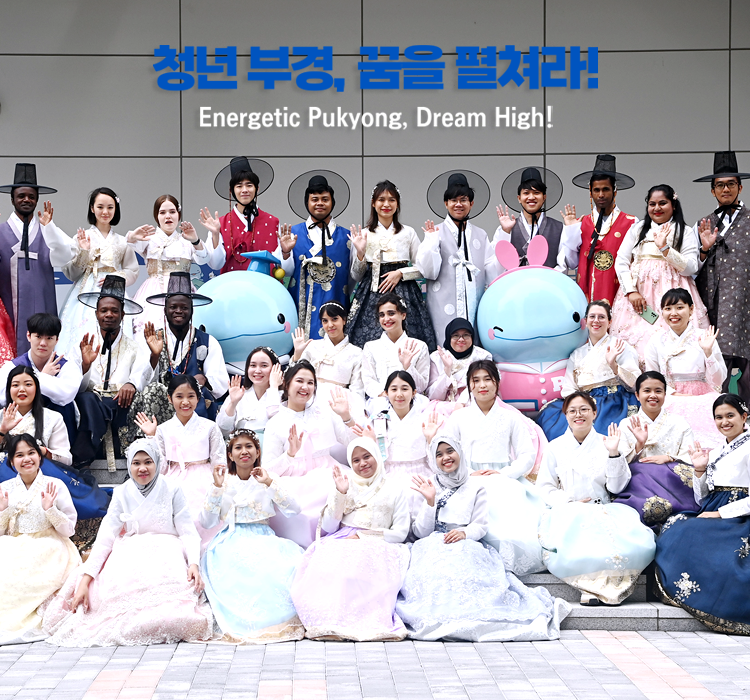


-
2025-2차 취업역량강화 캠프 참가 안내
2025-12-11 -
#### [한국수력원자력] 채용상담회 안내(12/15(월), 14:00~16:00, 동원장보고관 1층 학생취업설명회실(109호) ####
2025-12-11 -
[4단계 BK21대학원혁신사업] 2025-2학기 대학원생 「기술적 글쓰기」 프로그램 신청 안내
2025-12-09 -
◆ [국비지원]2026년 취업연계 교육생모집(소프트웨어 개발자) ◆
2025-12-03 -
▶2026학년도 1학기 부산공유대학 모집 공고◀
2025-12-12 -
★ 2026학년도 예비부경인 입학준비 종합안내 ★
2025-12-12 -
[채용공고] 국립부경대학교 체육진흥원 기간제계약직(헬스 강사, 당직 근무자) 채용 공고
2025-12-11
-
[교수학습지원팀] 2025학년도 동계 스피치 역량 강화 캠프 신청 안내
2025-12-08 -
[교수학습지원팀] 2025학년도 12월 학습법 특강 신청 안내(대면)
2025-11-28 -
제6기 비교과 서포터즈(bee-s) 모집 안내
2025-12-06 -
♥비교과 서포터즈 (비즈 bee-s)♥ 진길이의 성장일기 <27화>
2025-12-02 -
♥비교과 서포터즈 (비즈 bee-s)♥ [Bee-hind]옐로우 캠퍼스와 두근두근 매칭 이벤트
2025-12-02 -
♥비교과 서포터즈 (비즈 bee-s)♥ [Bee-log] 궁금하셨죠?! 이미지팀의 일상
2025-12-02 -
♥비교과 서포터즈 (비즈 bee-s)♥ 환승비즈, 비교과는 사랑과 같다…
2025-12-02
-
2026년 2월 졸업예정자 교원자격 무시험검정 원서접수 안내
2025-12-10 -
2025학년도 동계 계절수업 수강신청 취소 안내
2025-12-05 -
2026년 2월 학사학위취득유예 및 조기졸업 신청 안내
2025-12-01 -
2026학년도 1학기 재입학 신청 안내(학부)
2025-12-01 -
2025학년도 동계 계절수업 개강·폐강 교과목 알림 및 2차 수강신청 변경, 수강취소기간 안내
2025-11-26 -
2025학년도 동계 계절수업 등록금 납부 안내(25.12.1~12.5)
2025-11-18 -
2026년 2월 학부 2차 졸업예비사정 실시 안내
2025-11-04
-
2026학년도 1학기 국가장학금 1차 신청 안내['25. 11. 20.(목) 9시~12. 26.(금) 18시]
2025-11-17 -
2026년 신규 협성장학생 선발계획 공고<12/15(월)~1/5(월)>
2025-12-05 -
2026년 삼성드림클래스 대학생멘토 선발 공고<~ 12/20(토) 22시>
2025-12-03 -
2026학년도 (재)운해장학재단 장학생 추천 대상자 선발 모집 안내<12/8(월)~ 12/11(목) 16:00>
2025-12-02 -
2025년 2학기 거창군 지역출신 대학생 등록금 지원사업 안내<~11. 28.(금) 18:00>
2025-11-14 -
2025-2학기 (재)국립부경대학교발전기금 김정창 장학생<다문화, 탈북> 선발 안내<~ 11. 17.(월)>
2025-11-10 -
[한국고등교육재단] 문우림 제5기 장학생 선발 모집<~11/10(월)>
2025-11-07
-
[채용공고]입학전형 업무보조 일용직원 채용공고
2025-12-10 -
[채용공고] 국립부경대학교 이차전지특성화대학지원사업단 계약교수(산학중점) 채용 공고
2025-12-10 -
국립부경대학교 한시임기제 7호(사서) 경력경쟁채용 서류전형 합격자 및 면접시험 일정 공고
2025-12-08 -
[채용공고] 국립부경대학교 체육진흥원 기간제계약직(시설원) 채용 공고
2025-12-08 -
[채용공고]국립부경대학교 인문사회융합인재양성사업(HUSS) 포용사회사업단 전임연구원(계약직) 채용 공고
2025-12-04 -
[채용공고] 이차전지특성화대학지원사업단 사무원(기간제 계약직) 채용 공고
2025-12-02 -
[서류합격] 대학공무직(사무원, 전임연구원, 시설원, 국제교류원, 사무원, 공보담당관) 서류합격자 발표
2025-12-02
PUKYONG NATIONAL UNIVERSITY
부경나우
PUKYONG NATIONAL UNIVERSITY
부경나우
 학내 개인형 이동장치 안전수칙
학내 개인형 이동장치 안전수칙
 수상한 국립부경대
수상한 국립부경대
 평평하다평평해! 국립부경대학교
평평하다평평해! 국립부경대학교
 2025 International Summer School (국립부경대학교 부경국제계절학기)
2025 International Summer School (국립부경대학교 부경국제계절학기)
 여기서 부산 불꽃축제가 보인다고?
여기서 부산 불꽃축제가 보인다고?
 국립부경대학교 드론 풍경 홍보동영상
국립부경대학교 드론 풍경 홍보동영상
 대학 기숙사 앞 흔한 풍경 #기숙사 #광안리 #오션뷰
대학 기숙사 앞 흔한 풍경 #기숙사 #광안리 #오션뷰
 3개 大·지자체 뭉쳐 ‘부산 개방형 창업공유대학' 출범- 국립부경대·경성대·동명대·부산남구청, 25일 협약식·발대식
3개 大·지자체 뭉쳐 ‘부산 개방형 창업공유대학' 출범- 국립부경대·경성대·동명대·부산남구청, 25일 협약식·발대식
 대양의 영웅들 | 광복80주년 특별기획 | KBS 250826 ......
대양의 영웅들 | 광복80주년 특별기획 | KBS 250826 ......
 국립부경대-UNIST, 부산·울산 해양수산 AI 인재 양성 협력
국립부경대-UNIST, 부산·울산 해양수산 AI 인재 양성 협력
 국립부경대, 첨단 분야 정보융합대학 건물 신축 - 정보융합관 준공식 개최
국립부경대, 첨단 분야 정보융합대학 건물 신축 - 정보융합관 준공식 개최
 공룡이 있는 대학교가 있다?! | #부경고사우루스 #국립부경대학교 #shorts
공룡이 있는 대학교가 있다?! | #부경고사우루스 #국립부경대학교 #shorts
















